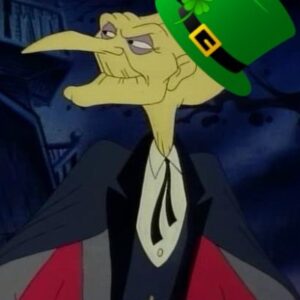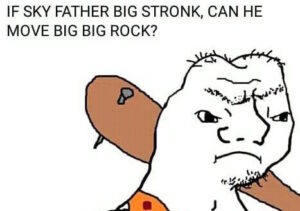The Most Important Event In TableTop (You’ve Probably Never Heard Of)
 Looking back on 2021, it occurred to me that the most important event in tabletop gaming in decades might have been the PvP death of Bob Dobs (run by Kestutis Kalvitis), who was eaten by cave bears on the command of Chief Fudd of Fug. Cirsova, the man behind the United Caveman Federation, tells the tale here, so let me just whet your appetite with this:
Looking back on 2021, it occurred to me that the most important event in tabletop gaming in decades might have been the PvP death of Bob Dobs (run by Kestutis Kalvitis), who was eaten by cave bears on the command of Chief Fudd of Fug. Cirsova, the man behind the United Caveman Federation, tells the tale here, so let me just whet your appetite with this:
I don’t have my stats at hand, but I’m pretty sure a lvl 2 fighter/level 1 cleric can’t take 10 cave bears in a fair fight. Let me see what kind of spells I have.
Ever the optimist, that Kes.
Why is that event – which happend almost exclusively between two players in backchannels and which others learned about later only because both players thought it too funny to keep to themselves – so important?
 You have to understand the state of RPGs at that time. The guys involved in the Trollopolous Campaign – and here Jeffro offers a second look at this critical event – were only just stepping out of four decades of bad/conventional gaming. The idea of patron-led factions was in its newly rediscovered infancy, and nobody really knew what the full ramifications of factions and PvP play would be. We certainly didn’t expect to completely revitalize adventure gaming by tearing it down and rebuilding it almost from the ground up. We were just playing with the ramifications of AD&D run strictly by-the-book and seeing where the natural consequences would take us.
You have to understand the state of RPGs at that time. The guys involved in the Trollopolous Campaign – and here Jeffro offers a second look at this critical event – were only just stepping out of four decades of bad/conventional gaming. The idea of patron-led factions was in its newly rediscovered infancy, and nobody really knew what the full ramifications of factions and PvP play would be. We certainly didn’t expect to completely revitalize adventure gaming by tearing it down and rebuilding it almost from the ground up. We were just playing with the ramifications of AD&D run strictly by-the-book and seeing where the natural consequences would take us.
Bob Dobs was the first multi-classed character to level in Trollopolous and DM Jeffro didn’t even know what he was doing out there in UCF territory. (There’s that fog of war we talked about yesterday.) His death represented a bombshell dropped into the campaign – and the hobby as a whole – for a number of reasons.
For my part, it was the first time that PvP really clicked. The reaction of Bob’s player to death caused by another player – a shrug and a laugh and reaching for the dice – represented proof-positive that PvP really could work. All it took was the right attitude among the participants. The death of Bob resulted from incomplete knowledge of his opponent and the natural result of Cirsova playing Chief Frug completely in-character. Kes accepted defeat with aplomb and the campaign moved forward without so much as a hiccup.
In four decades of gaming I’ve seen countless conventional tables blow up over PC death at the hands of other PCs. It’s seen as a hostile action that betrays the social compact of a party of adventurers. I’ve even seen campaigns wither on the vine because in-party tensions resulted in parties that simply couldn’t work together. For once, players went head-to-head and it didn’t just kill the campaign, it enhanced it. Suddenly, no character was truly safe, and everyone had to engage in serious diplomatic negotiations to acquire allies and insurance against the predations of other players.
And it was fun!
There’s room here for a look at how alignments, properly understood as factions in their own right rather than vague personality test results, lubricate and streamline the process of finding out who is ‘us’ verus who is ‘them’, but that’s left as an exercise for the reader. For now.
But wait! There’s more. After mentioning this in back channels, friend of the blog Kalvitis himself pointed out:
It was also significant because it was a lowly PC muscling in on a “Patrons Only” phase and it worked (not the surviving part).
Now that’s really important because everyone saw, for the first time, how well AD&D and the classic adventure game style of play bridged the gap between low-level and high-level play. You had a barely levelled character’s hijinks kickoff some big movements among the factions. As Brenninger points out, this also proved:
The idea that your character may die, even early on in a game, and yet their death totally changed the events that would happen in the future. Every player action counts.
It was a literal game-changer.
Big events were already happening in the campaign, and would likely have led to the same conclusion, but you have to credit Jeffro and Kes and Cirsova. They got there first. They proved that the new model, rough as it was, had some teeth. Two players could get together and role-play an encounter on their own, and even deadly results didn’t cause the death of the campaign.
It was the beginning of four years and counting of pushing the boundaries of what these games are capable of. While it all looks inevitable now, it didn’t look that way at the time. Without this little mini-game and the courage of the players – and the willingness of a DM to loosen the reins of his campaign – it’s not entirely clear that we would be where we are today.
I think another significant thing that it brought up was that you could not only do things in downtime, you could be killed in downtime activities. This was a non-standard encounter in non-session play that led to a non-standard game over for Kes’s character.
I would not say this was truly PvP, because I was running the UCF as though I were a co-DM running for a player who wanted downtime activity in the area I controlled and knew intimately so that Jeffro didn’t have to.
Despite the manner of Bob’s death, I tried to play the encounter fair, giving Kes as many outs as possible. Kes pushed his luck, in part, because a character being killed in a downtime activity was something wholly new and therefore unexpected. I don’t think that Kes had initially considered the possible ramifications of interacting with the tribe in a proselytory manner, but he met the fate of many a lone missionary to savage peoples. The fact that he was willing to roll with it and accepted not only what had happened but that he had earned it, DID have huge ramifications on what became possible in Always-On D&D.
Fascinating stuff, really.
Perhaps I should orchestrate and encourage more violence. . .
If John Wick kills Macho Macho Man instead of allying with him…